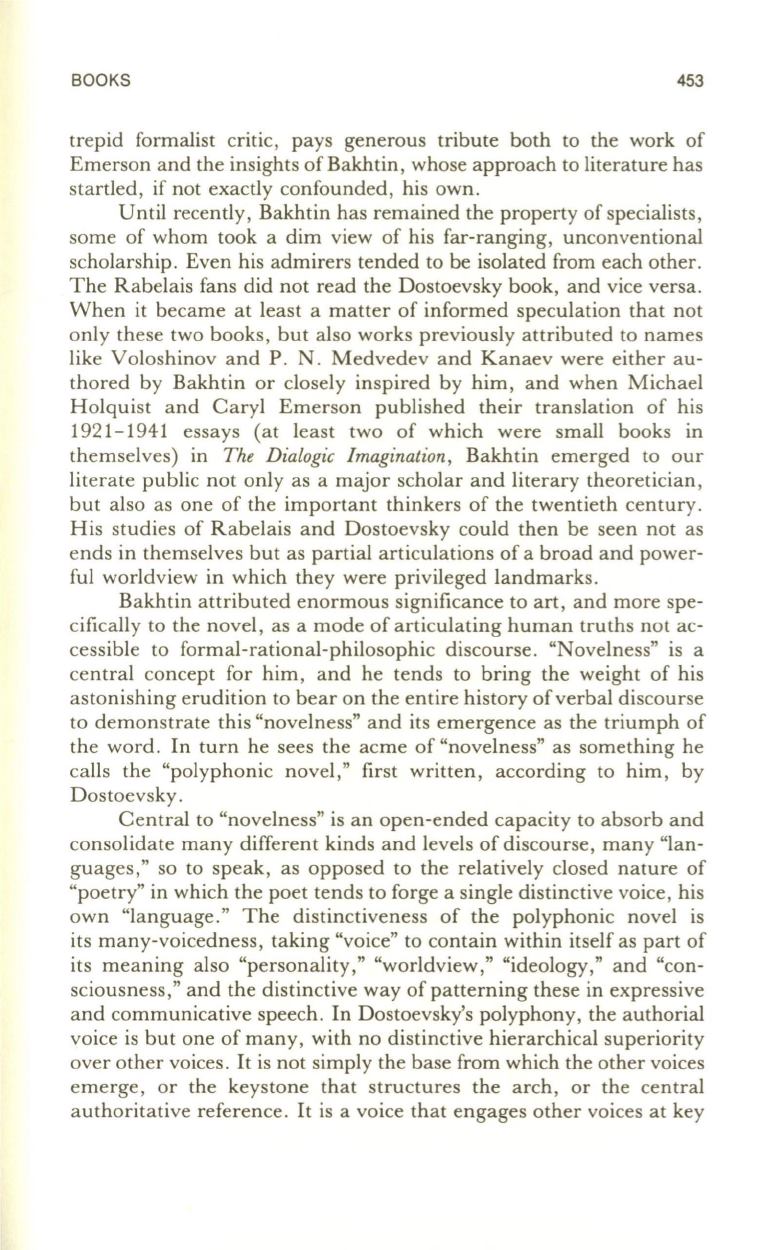
BOOKS
453
trepid formalist cntIC, pays generous tribute both to the work of
Emerson and the insights of Bakhtin , whose approach to literature has
startled, if not exactly confounded, his own.
Until recently, Bakhtin has remained the property of specialists,
some of whom took a dim view of his far-ranging, unconventional
scholarship. Even his admirers tended to be isolated from each other.
The Rabelais fans did not read the Dostoevsky book, and vice versa.
When it became at least a matter of informed speculation that not
only these two books, but also works previously attributed to names
like Voloshinov and P. N. Medvedev and Kanaev were either au–
thored by Bakhtin or closely inspired by him, and when Michael
Holquist and Caryl Emerson published their translation of his
1921-1941 essays (at least two of which were small books in
themselves) in
The Dialogic Imagination,
Bakhtin emerged to our
literate public not only as a major scholar and literary theoretician,
but also as one of the important thinkers of the twentieth century.
His studies of Rabelais and Dostoevsky could then be seen not as
ends in themselves but as partial articulations of a broad and power–
ful worldview in which they were privileged landmarks .
Bakhtin attributed enormous significance to art, and more spe–
cifically to the novel, as a mode of articulating human truths not ac–
cessible to formal-rational-philosophic discourse. "Novelness" is a
central concept for him, and he tends to bring the weight of his
astonishing erudition to bear on the entire history of verbal discourse
to demonstrate this "novelness" and its emergence as the triumph of
the word. In turn he sees the acme of "novelness" as something he
calls the "polyphonic novel," first written, according to him, by
Dostoevsky .
Central to "novelness" is an open-ended capacity to absorb and
consolidate many different kinds and levels of discourse, many "lan–
guages," so to speak, as opposed to the relatively closed nature of
"poetry" in which the poet tends to forge a single distinctive voice, his
own "language." The distinctiveness of the polyphonic novel is
its many-voicedness, taking "voice" to contain within itself as part of
its meaning also "personality," "worldview," "ideology," and "con–
sciousness," and the distinctive way of patterning these in expressive
and communicative speech. In Dostoevsky's polyphony, the authorial
voice is but one of many, with no distinctive hierarchical superiority
over other voices. It is not simply the base from which the other voices
emerge, or the keystone that structures the arch, or the central
authoritative reference. It is a voice that engages other voices at key


